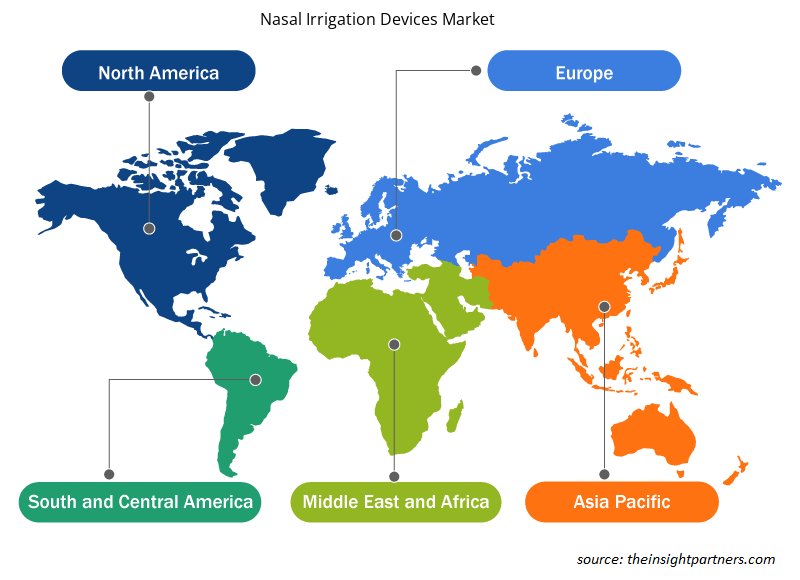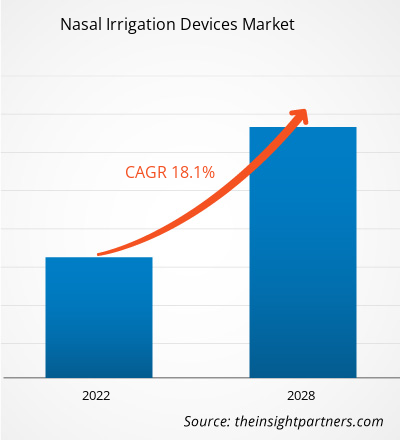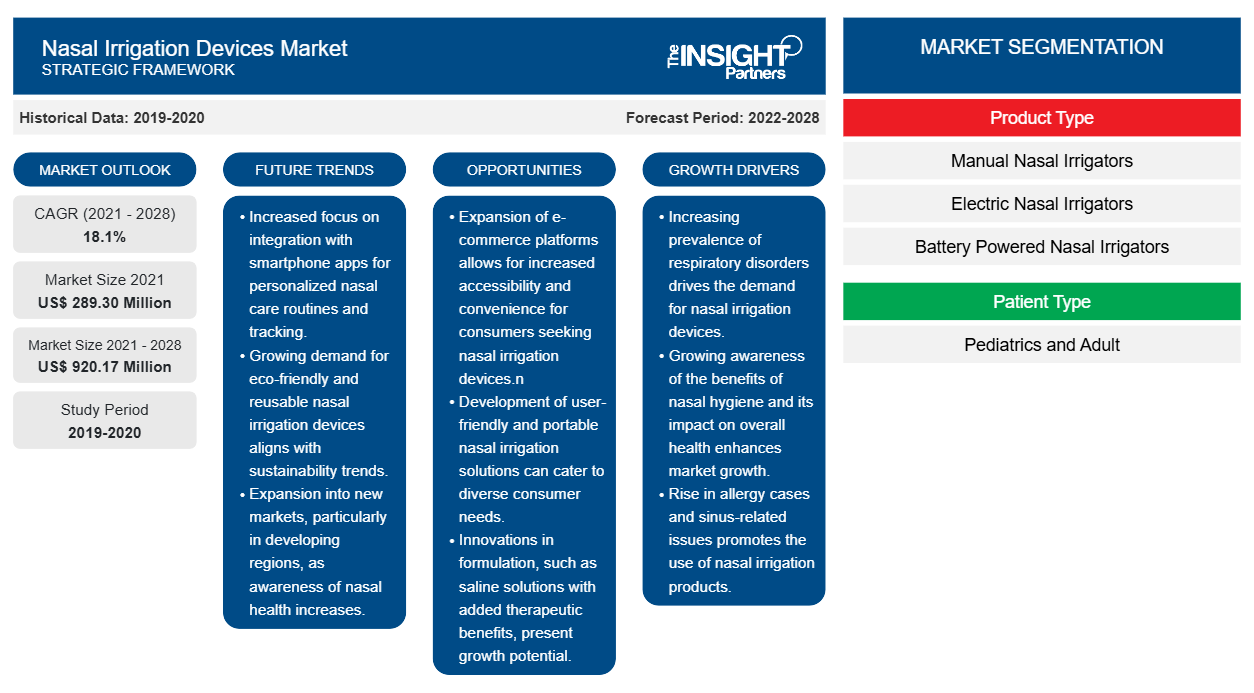Le marché des dispositifs d'irrigation nasale était évalué à 289,30 millions de dollars américains en 2021 et devrait croître à un TCAC de 18,1 % de 2022 à 2028.
L'irrigation nasale est une pratique traditionnelle qui consiste à nettoyer les voies nasales à l'aide d'une solution saline et d'eau distillée à l'aide d'appareils tels que le pot neti, le flacon souple et les irrigateurs nasaux électriques. Ces appareils sont dotés de buses spécialement conçues qui facilitent le nettoyage efficace et effectif des voies nasales.
Le marché des dispositifs d'irrigation nasale est segmenté en type de produit, type de patient, application, utilisateur final et géographie. Par géographie, le marché est largement segmenté en Amérique du Nord, Europe, Asie-Pacifique, Moyen-Orient et Afrique, et Amérique du Sud et centrale. Ce rapport offre des informations et une analyse approfondie du marché, en mettant l'accent sur des paramètres tels que les tendances du marché et la dynamique du marché. Il comprend également l'analyse concurrentielle des principaux acteurs du marché des dispositifs d'irrigation nasale.
Personnalisez ce rapport en fonction de vos besoins
Vous bénéficierez d'une personnalisation gratuite de n'importe quel rapport, y compris de certaines parties de ce rapport, d'une analyse au niveau des pays, d'un pack de données Excel, ainsi que de superbes offres et réductions pour les start-ups et les universités.
-
Obtenez les principales tendances clés du marché de ce rapport.Cet échantillon GRATUIT comprendra une analyse de données, allant des tendances du marché aux estimations et prévisions.
Informations sur le marché
L'augmentation de la prévalence des allergies nasales et des maladies infectieuses et la sensibilisation croissante aux avantages de l'irrigation nasale stimulent la croissance du marché des dispositifs d'irrigation nasale
Au cours des dernières années, les cas d’allergies et de maladies infectieuses affectant les voies respiratoires supérieures ont considérablement augmenté. On a constaté une augmentation significative des sinusites, des rhinites, des bronchiolites et d’autres affections postopératoires, qui nécessitent une irrigation nasale pour une guérison rapide ; une inflammation et un dépôt bactérien supplémentaires peuvent aggraver les conditions. Selon un rapport du Sinus & Allergy Wellness Center, la sinusite touche 30 millions d’adultes chaque année aux États-Unis ; environ 11,6 % des adultes américains ont reçu un diagnostic de sinusite en 2020. Par conséquent, la prévalence croissante de la sinusite a affecté les activités d’un individu, favorisant la demande d’irrigation nasale et stimulant le marché des dispositifs d’irrigation nasale. Une augmentation de la prévalence des infections des voies respiratoires supérieures dans un contexte d’industrialisation rapide et d’augmentation des niveaux de pollution alimente également la demande de dispositifs d’irrigation nasale. Avec l’augmentation de la pollution, les allergènes et les polluants présents dans l’air peuvent provoquer un blocage des voies nasales, et le dépôt excessif de ces produits chimiques ou substances peut en outre entraîner une sinusite et d’autres problèmes nasaux. L'irrigation nasale est bénéfique en facilitant l'élimination des allergènes, en éliminant les liquides, en améliorant la respiration, en dégageant les sinus, etc. Dernièrement, la prise de conscience de ces avantages a augmenté parmi les consommateurs, ce qui se traduit par une forte demande de dispositifs d'irrigation nasale.
L'irrigation nasale, qui est désormais adoptée dans le monde entier, a une longue histoire qui remonte à l'Ayurveda. Néanmoins, les dispositifs d'irrigation nasale ont évolué de manière notable, passant des bouteilles compressibles aux pots neti. Les dispositifs d'irrigation nasale alimentés par batterie et électriques, qui gagnent en popularité, permettent un flux constant d'eau saline dans la cavité nasale. Les économies en développement d'Asie-Pacifique et d'Amérique du Sud et d'Amérique centrale se concentrent sur le développement et l'utilisation de tels dispositifs. PT Kalbe Farma Tbk a lancé le premier nettoyeur nasal électrique jamais fabriqué en Indonésie sous la marque Elvasense Portable Nasal Washer. Le développement continu de nouveaux dispositifs pour de meilleurs résultats et une augmentation de la production de dispositifs d'irrigation nasale dans les économies en développement devraient créer des opportunités lucratives pour la croissance du marché au cours de la période de prévision.
Informations sur les types de produits
En fonction du type de produit, le marché des dispositifs d'irrigation nasale est segmenté en irrigateurs nasaux manuels, irrigateurs nasaux électriques et irrigateurs nasaux alimentés par batterie. Le segment des irrigateurs nasaux manuels est en outre segmenté en pot neti, flacon compressible et seringue à poire pour bébé. Le segment des irrigateurs nasaux manuels détenait la plus grande part de marché en 2021. Cependant, le segment des irrigateurs nasaux alimentés par batterie devrait enregistrer le TCAC le plus élevé au cours de la période de prévision en raison de la tendance à la hausse des produits de santé portables.
Informations sur les types de patients
En fonction du type de patient, le marché des dispositifs d'irrigation nasale est divisé en deux catégories : adulte et pédiatrie. En 2021, le segment adulte détenait une part de marché plus importante. De plus, le même segment devrait connaître le TCAC le plus rapide de 2022 à 2028. La domination du marché de ce segment est attribuée à la demande croissante de dispositifs d'irrigation nasale pour traiter les infections des sinus, les allergies, le rhume et la grippe, en particulier parmi les populations gériatriques croissantes dans le monde.
Informations sur les applications
En fonction des applications, le marché des dispositifs d'irrigation nasale est segmenté en sinus, rhinite, bronchiolite, affections respiratoires postopératoires et autres. En 2021, le segment des sinus détenait la plus grande part du marché. En outre, le même segment devrait enregistrer le TCAC le plus élevé de 2022 à 2028. La croissance du marché de ce segment est attribuée à l'augmentation des affections des sinus et aux initiatives prises par les principaux acteurs.
Informations sur l'utilisateur final
En fonction de l'utilisateur final, le marché des dispositifs d'irrigation nasale est segmenté en établissements de soins à domicile, hôpitaux et cliniques, et autres. En 2021, le segment des soins à domicile détient la plus grande part du marché et devrait enregistrer le TCAC le plus rapide de 2022 à 2028.
Les développements inorganiques tels que les fusions et acquisitions et l'expansion sont des stratégies largement adoptées par les acteurs du marché mondial des dispositifs d'irrigation nasale. Quelques-uns des développements clés récents du marché sont énumérés ci-dessous :
- En mai 2022, Medtronic a annoncé l'acquisition d'Intersect ENT, élargissant ainsi le portefeuille complet de produits ORL de la société avec des produits innovants utilisés dans les procédures des sinus pour améliorer les résultats postopératoires et traiter les polypes nasaux. Les gammes de produits et la clientèle d'Intersect ENT renforceront les efforts de Medtronic pour avoir un impact positif sur les patients souffrant de rhinosinusite chronique (RSC).
- En novembre 2021, NeilMed Phamaceuticals Inc. a annoncé une expansion significative de ses installations de production du comté de Sonoma, alors que les ventes augmentent, en particulier en dehors des États-Unis.
- En octobre 2021, Air Liquide a annoncé l'acquisition de Betamed SA, un important fournisseur de soins de santé à domicile en Pologne, pour développer son activité de soins de santé à domicile en Europe.
Aperçu régional du marché des dispositifs d'irrigation nasale
Les tendances et facteurs régionaux influençant le marché des dispositifs d’irrigation nasale tout au long de la période de prévision ont été expliqués en détail par les analystes d’Insight Partners. Cette section traite également des segments et de la géographie du marché des dispositifs d’irrigation nasale en Amérique du Nord, en Europe, en Asie-Pacifique, au Moyen-Orient et en Afrique, ainsi qu’en Amérique du Sud et en Amérique centrale.

- Obtenez les données régionales spécifiques au marché des dispositifs d'irrigation nasale
Portée du rapport sur le marché des dispositifs d'irrigation nasale
| Attribut de rapport | Détails |
|---|---|
| Taille du marché en 2021 | 289,30 millions de dollars américains |
| Taille du marché d'ici 2028 | 920,17 millions de dollars américains |
| Taux de croissance annuel moyen mondial (2021-2028) | 18,1% |
| Données historiques | 2019-2020 |
| Période de prévision | 2022-2028 |
| Segments couverts |
Par type de produit
|
| Régions et pays couverts |
Amérique du Nord
|
| Leaders du marché et profils d'entreprises clés |
|
Densité des acteurs du marché des dispositifs d'irrigation nasale : comprendre son impact sur la dynamique commerciale
Le marché des dispositifs d'irrigation nasale connaît une croissance rapide, tirée par la demande croissante des utilisateurs finaux en raison de facteurs tels que l'évolution des préférences des consommateurs, les avancées technologiques et une plus grande sensibilisation aux avantages du produit. À mesure que la demande augmente, les entreprises élargissent leurs offres, innovent pour répondre aux besoins des consommateurs et capitalisent sur les tendances émergentes, ce qui alimente davantage la croissance du marché.
La densité des acteurs du marché fait référence à la répartition des entreprises ou des sociétés opérant sur un marché ou un secteur particulier. Elle indique le nombre de concurrents (acteurs du marché) présents sur un marché donné par rapport à sa taille ou à sa valeur marchande totale.
Les principales entreprises opérant sur le marché des dispositifs d'irrigation nasale sont :
- Systèmes médicaux Air Liquide
- PHARMACEUTIQUES NEILMED INC.
- Société Stryker
- SinuPulse; Force de guérison
- Bremed Limitée
Avis de non-responsabilité : les sociétés répertoriées ci-dessus ne sont pas classées dans un ordre particulier.

- Obtenez un aperçu des principaux acteurs du marché des dispositifs d'irrigation nasale
Profils d'entreprise
- Systèmes médicaux Air Liquide
- NEILMED PHARMACEUTICALS INC
- Société Stryker
- SinuPulse
- Force de guérison
- Bremed Ltée.
- RhinoSystems, Inc
- Flaem Nuova SpA
- Medtronic Plc
- Bayer AG
- Analyse historique (2 ans), année de base, prévision (7 ans) avec TCAC
- Analyse PEST et SWOT
- Taille du marché Valeur / Volume - Mondial, Régional, Pays
- Industrie et paysage concurrentiel
- Ensemble de données Excel
Rapports récents
Rapports connexes
Témoignages
Raison d'acheter
- Prise de décision éclairée
- Compréhension de la dynamique du marché
- Analyse concurrentielle
- Connaissances clients
- Prévisions de marché
- Atténuation des risques
- Planification stratégique
- Justification des investissements
- Identification des marchés émergents
- Amélioration des stratégies marketing
- Amélioration de l'efficacité opérationnelle
- Alignement sur les tendances réglementaires























 Obtenez un échantillon gratuit pour - Marché des dispositifs d'irrigation nasale
Obtenez un échantillon gratuit pour - Marché des dispositifs d'irrigation nasale